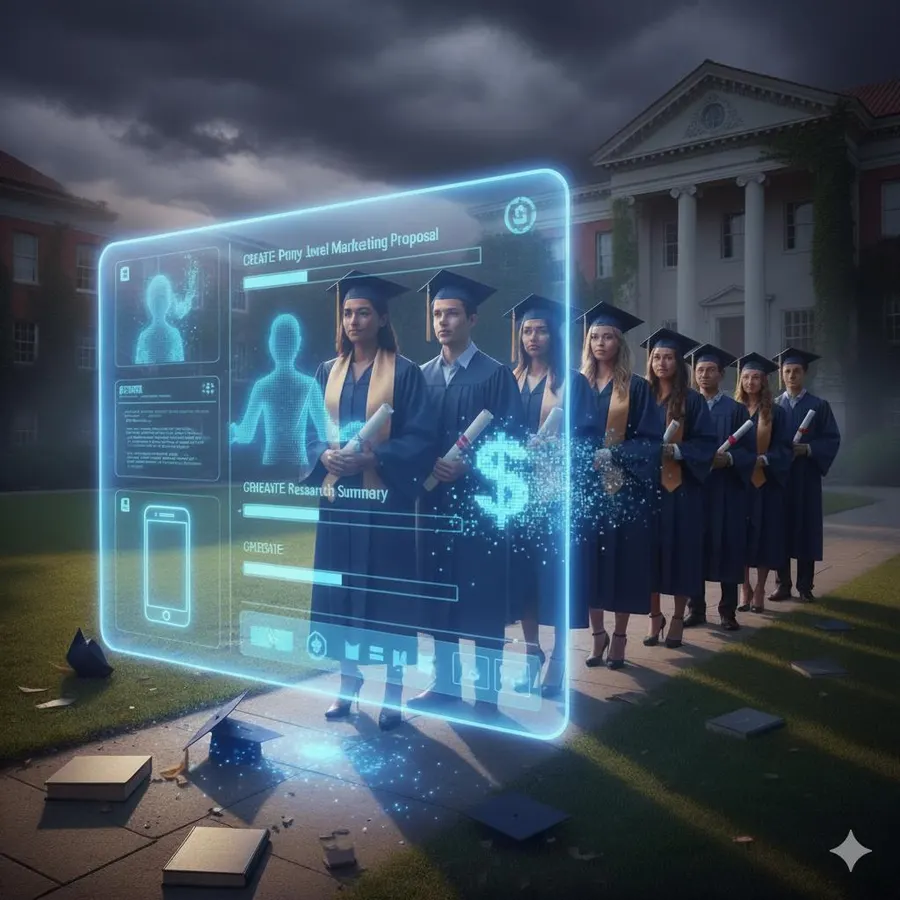By Benjamin Selznick,Contributor
Copyright forbes

Image of college graduates looking at a generative AI interface. Image created by Author using Google Gemini.
Google Gemini
While much has been written about the disruptive nature of artificial intelligence (AI) in terms of its pernicious effects on college student learning (or lack thereof), another and potentially more profound concern is emerging: entry level jobs are being erased. As described in a BBC interview with LinkedIn executive Aneesh Raman, recent university graduates might well be entering a ‘perfect storm’ of challenging, if not downright brutal, hiring conditions.
In this piece, we bring together our perspectives as educators and AI specialists to take a closer look at these labor market realities and what they might portend for higher education in a future so near, it may already be happening. We then provide a few suggestions on how colleges and universities might respond in innovative ways.
To begin, let’s start with the unmistakable link between pursuing higher education and employment. While long a consideration, increases in higher education costs and labor market competition have only elevated the importance of college in advancing one’s career. As a recent survey reported by Inside HigherEd found, “Just over half (51 percent) of students say they enrolled in higher education for higher earning potential, 45 percent are looking to access better job benefits and 40 percent say their field of study requires a degree.” Certainly, colleges and universities themselves have rightly touted their benefits as an essential bridge between prior learning experiences and a more rewarding and fulfilling ‘first destination’ post-college.
But what happens when these job outcomes are less secure? And what will happen as breaking into the labor market – for both undergraduate and graduate degree holders – becomes more (potentially much more) challenging?
Let’s look at the data. While in the aggregate over the lifespan college holds one of the absolute best return on investments one can hope to achieve, current labor market trends paint a more nuanced picture for recent graduates. Forbes reported on September 10th that BLS revised down its job growth estimates by nearly one million positions between March 2024 and March 2025. This article notes that “the AI wild card” is rapidly reshaping the jobs landscape and not doing so in favor of those with newly minted college degrees. Notably, a study published in August 2025 from the Stanford Digital Economy Lab not only found that “since the widespread adoption of generative AI, early-career workers (ages 22-25) in the most AI-exposed occupations have experienced a 13 percent relative decline in employment even after controlling for firm-level shocks” but also suggested that such data may well serve as the “canary in the coal mine” for broader workforce disruption.
MORE FOR YOU
This prediction tracks with two other sobering realities. First are persistent concerns regarding the underemployment and long-term unemployment of college graduates. As the second piece, published in the New York Times on September 15th reveals, college graduates searching for jobs are seemingly getting burned by AI twice: once due to the replacement of their potential contributions by generative AI and again when HR functions utilizing AI make it more difficult to stand out in a crowded, algorithmically driven process. The impact on individuals is, to put it mildly, discouraging. The second reality is that the ‘party’ isn’t over yet. Reflect, for a moment, on these two data points released by McKinsey & Company in January 2025: “92% of companies plan to invest more in generative AI over the next 3 years; 1% believe their current investments have reached maturity.” The prognosis that these numbers translate into more entry-level jobs? Grim.
So what should colleges be doing? Two general ideas: continue emphasizing whole student development and continue articulating their value.
Regarding student development, it remains essential that colleges continue to maintain their position as the primary location of learning and skill acquisition required for a globalizing economic future. As recently noted by the World Economic Forum Future of Jobs Report 2025, these skills not only include technical proficiencies and knowledge of what to do but also how to engage ideas and other humans while regulating one’s own emotional world. As the report notes: “Creative thinking and resilience, flexibility and agility are also rising in importance, along with curiosity and lifelong learning.” Fortunately, these are areas of growth for adults of all ages that colleges and universities have a proven track record of excellence in promoting (e.g., my own work on developing students’ innovation capacities). Additionally, institutions of higher education must pay close(r) attention to ensuring that graduates – especially Gen Z undergraduates – are more comprehensively prepared to step into professional environments and begin contributing as effective team members (especially in-person) from day one. Such efforts can certainly exist within the formalized career development realm (e.g., internships, mentorships), but opportunities such as experiential learning, study abroad, and general education also have important roles to play.
Importantly, and over time for certain institutions existentially, colleges must also continue to articulate their long-term value. As discussed in the aforementioned BBC interview, the next decade of work and career will be bumpy and difficult to predict. However, two- and four-year colleges can accurately position themselves as the place and space to prepare as comprehensively as possible for those realities. This absolutely includes futures across the full scope of the economic landscape, including addressing the profound skills gap in technical education. In practice, colleges must continue to innovate classrooms without ignoring decisions made in boardrooms and comprehensively explain their choices to all stakeholders.
Though colleges and universities ultimately have little control over the labor market, they have profound autonomy in how they respond to meet the challenges posed by AI as concerns first-destination employment. As institutions closely examine and respond to these evolving realities, it is imperative that they take student and employer concerns seriously and listen to industry partners with curiosity instead of judgment. Rather than adopt inflexible, rigid positions of ‘we know best’, institutions must truly learn as they go and address the future with an eye toward long term student success even amidst disruption. Only then will they be able to preserve their value and ensure that they thrive in the coming decade of rapid technological and societal transformation.
Tatjana Titareva, PhD, is a Staff Scientist at the AI Policy Lab in the Department of Computing Science, Umeå University, Sweden.
Editorial StandardsReprints & Permissions



